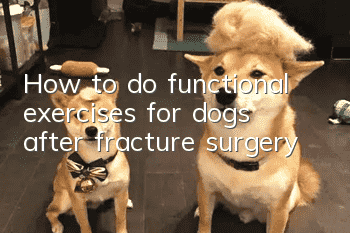How to do functional exercises for dogs after fracture surgery

People must undergo rehabilitation after a fracture or injury, and dogs after a fracture are no exception. A series of functional exercises must be carried out for dogs so that they can drive better and faster healthily. So functional exercises should How to proceed?
Labrador Retriever
Functional exercise for fractures can improve local blood circulation, enhance bone metabolism, accelerate fracture repair and functional recovery of the diseased limb, prevent the occurrence of widespread pathological callus, muscle atrophy, joint stiffness, joint capsule contracture and other sequelae and promote the recovery of function. important guarantee, and it is also an important part of the treatment of fractures.
Exercises for fractures include early massage, traction exercises, extension and flexion of the unfixed joints above and below the fracture, etc. Exercises for fractures can be divided into three stages: early, middle and late according to the healing process of the fracture.
Early stage (organizing stage of hematoma inflammation): In the early stage, within 1-2 weeks after the fracture, the affected limb is locally swollen and painful. The soft tissue is in the repair stage and is prone to re-displacement. The purpose of functional exercise is to promote blood circulation in the affected limb, eliminate swelling, and prevent muscle atrophy. You can massage the underside of the bandage and do some gentle flexion and stretching of the joints.
Middle stage (original callus formation stage): The middle stage is 2 weeks after the fracture. Generally, for a normal fracture, local swelling subsides, pain disappears, soft tissue repairs, and the fracture end has been connected by fibers and Callus is forming. At this stage, joint activities above and below the fracture should begin. The purpose is to improve blood circulation and prevent muscle atrophy and joint stiffness. It can be allowed to move freely in a small space, and the floor should be dry and clean. Or lead the dog gradually, depending on the pet's condition, for 10-15 minutes each time, 1-2 times a day, and gradually extend the time as the condition improves. Generally, there will be a systemic reaction and the lameness will worsen in the first few days, but it will gradually improve later.
Late stage (callus reconstruction and shaping stage): In this period, the activities of joints around the fracture and the whole body will continue to be strengthened, mainly to strengthen the active movement of the affected limb, and to promote the recovery of joint range of motion and muscle strength.
The treatment of pet fractures is not simply reduction, fixation and waiting for recovery. Post-fracture functional exercise also plays an indispensable role in the treatment of fractures. The saying "three points of treatment, seven points of exercise" vividly illustrates Got this. Exercise has many benefits. Not only can it help with recovery, but it can also help your pet recover faster. Exercise after fracture also has two benefits:
First, it promotes swelling and prevents joint adhesions and stiffness. After a fracture, the soft tissue at the fracture site generally has varying degrees of bleeding and edema, and lumps will appear on the injured limb. If the lump is not eliminated in time, it will cause adhesion and even hardening of the corresponding soft tissue. This kind of adhesionIt can also occur within muscles and tendons, between tendons and synovium, and within joints, thereby affecting the function of muscle contraction. This can be avoided through functional exercises.
Second, promote fracture healing. Through functional exercise, the muscles of the injured limb undergo repeated contraction and contraction activities, which can strengthen the longitudinal extrusion force of the fracture, make the fracture gap smaller, and make the fracture more stable, which can improve the nutrition of the fracture and promote the healing of the fracture. Functional exercises can also correct minor fracture dislocations and facilitate fracture healing.
To sum up, exercise after a fracture should follow the principle of gradual progress and be divided into three periods. Reasonable exercise in different periods can promote fracture healing and prevent joint stiffness and muscle atrophy, which is extremely important for the recovery of your pet.
- Precautions for deworming dogs in summer
- Tips for training golden retrievers to use the toilet
- Tips to prevent your dog from losing hair frequently
- Giant Maine Coon, the cat you can afford but not keep!
- Which brand of dog disinfectant is good? Recommend a useful dog odor deodorant disinfectant!
- What are the training tips for German Longhaired Pointer dogs?
- Skin diseases - pet grooming killers, how much do you know?
- The heat is unbearable, can my dog eat popsicles?
- What should you do if your dog has a cold and vomits?
- What are the common diseases of Chihuahuas?



